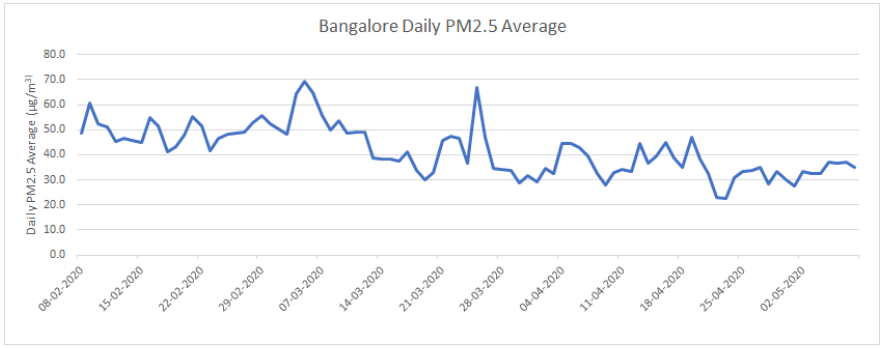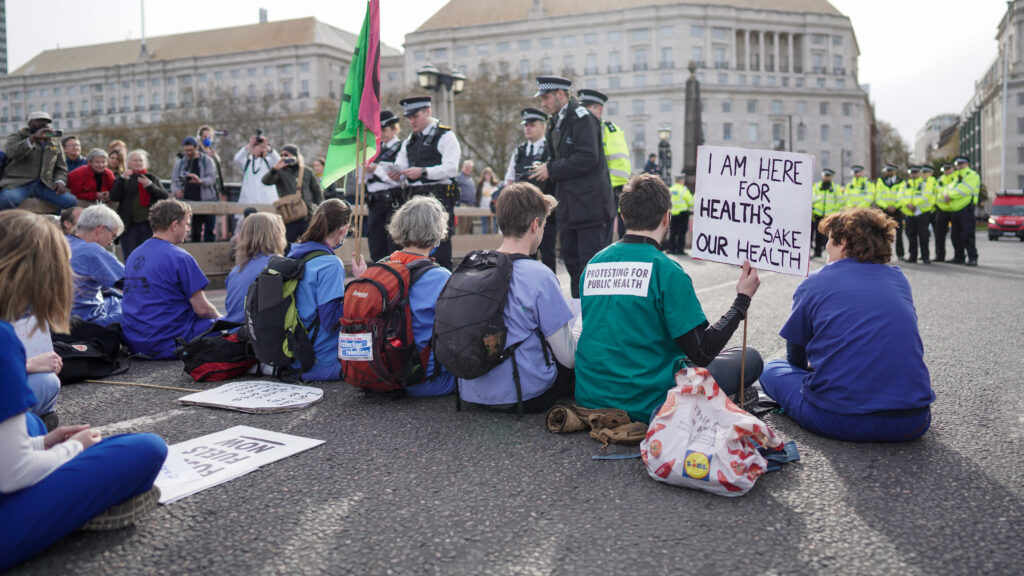
Greater policy commitment by Mayor of Bengaluru and Chief Secretary of Karnataka required to turn short-term reductions into long-lasting good air quality as part of recovery from the pandemic.
Bengaluru, India, 22 June 2020:- Air pollution in Bengaluru dropped by 28% during the Indian megacity’s coronavirus lockdown, according to analysis released today.
The analysis of air quality data by the Centre for Research on Energy and Clean Air (CREA), collected by Bengaluru’s Healthy Air Coalition, shows that air pollution during the Covid-19 lockdown period, measured as PM2.5, was reduced by an average of 28% [1]. Additional analysis of satellite data confirms the downward trend in emissions during lockdown.
This analysis, Impact of Covid lockdown on Air Pollution Levels in Bengaluru, was completed by CREA on behalf of the Health and Environment Alliance (HEAL) and the Global Climate and Health Alliance (GHCA). GCHA and HEAL support Healthy Air Coalition Bengaluru, as part of a global health sector initiative for clean air in cities in 2030. The Healthy Air Coalition has set up a network of 30 air quality monitors across the city (in places frequented by groups most at risk from air pollution) in order to provide publicly accessible data to assess the health burden of air pollution in Bengaluru and drive measures for improving air quality [2].
Benglaru is a city of 11 million people, making it the third most populous city in India. Emissions from vehicular pollution are a key contributor to air pollution in Bengaluru, which is the most traffic-congested city in India. Cases of child asthma, upper respiratory infections, chronic pulmonary disease, as well as heart attacks in young people are reported to be on the increase [3]. Doctors and health professionals point to chronic exposure to air pollution as a possible cause in the rise of ill-health to air pollution – prompting the 2019 launch of the Healthy Air Coalition, which installed a network of air quality monitors and will be carrying out an analysis of health impacts of poor air quality in the city.
The Healthy Air Coalition has spent 12 months collecting data from 26 stationary air quality monitors across the Southern Indian city . Data for a 45-day period before the lockdown (8th February 2020 to 23rd March 2020) was compared with data from a 45-day period during the lockdown (25th March to 8th May 2020) to better understand the impact of reduced economic activity and transport on air quality.
The reduction in pollution levels varied for locations across the city, ranging from the lowest cut of 13% at Halasuru hospital to the greatest cut at Bellandur lake, where pollution dropped by 73%.
Aishwarya Sudhir, Coordinator of the Healthy Air Coalition said, “The Healthy Air Coalition has been monitoring local air quality using a network of monitors across the city for over 12 months. By chance, we have been able to assess the impacts of lockdown on air quality and it appears that pollution from PM2.5 has been cut by more than a quarter on average. In some places air quality has actually met WHO safe levels, possibly for the first time in two decades”.
On average, PM 2.5 levels in Bengaluru from all monitoring stations reduced by approx 28% in the 45 day period during the lockdown compared to 45 days before the lockdown.
Before COVID-19, pollution – from traffic, solid waste burning, residential cooking and heating, and dust from road works and construction – led to constant poor air quality, failing to meet even Indian air quality standards, and substantially out of line with WHO air quality recommendations. Air pollution is associated with increased risk of pneumonia, chronic obstructive pulmonary disease, lung cancer, heart disease and strokes, leading to seven million premature deaths each year globally [4]. According to the Lancet, 12.5% of deaths in India are due to poor air quality, and half of those deaths are people dying below age 70. [5]
Dr KR Bharath Kumar Reddy – Pediatric Pulmonologist & Director, Shishuka Children’s Hospital, Bengaluru said: “A significant improvement in air quality in Bangalore during the lockdown clearly indicates the significant contribution of traffic to air pollution. Seeing a drop in levels more so in areas which are known to be the tech-corridors of the city during a period of work-from-home (WFH) also points in this favour. This reiterates the need for us to take traffic regulation more seriously and implement strategies to control vehicular emission in our city to help improve the air quality. We have also witnessed a significant drop in respiratory symptoms in children during the lock-down. The improvement in air-quality could be an important contributing factor for the same.”
Scientists around the world have reported improvements in air quality during lockdown in cities from Beijing to London, Milan to Delhi [6]. While this occurred at enormous social and economic cost, due to the Covid-19 pandemic and the impact of reduced economic activity, it has illustrated the health and environmental benefits of reduced fossil fuel use in transport and energy.
The Healthy Air Coalition has written an open letter to the Mayor of Bengaluru today calling for a Healthy Recovery which builds upon solutions such as the Yulu bikeshare system and electrification of transport [7,8]. The recovery agenda should include a robust plan to implement active and sustainable transport with dedicated paths for walking and lanes for cycling, promotion of electric vehicles and the necessary infrastructure, a curb on burning of solid waste, and implementation of construction and debris laws.
Analysis: Impact of Covid lockdown on Air Pollution Levels in Bengaluru
ENDS
Contacts:
Bengaluru: Aishwarya Sudhir, Air Quality and Health Programme Lead for the Health and Environment Alliance (HEAL), +91 998 6808 067, [email protected]
International: Dave Walsh, Communications Advisor, Global Climate and Health Alliance, +34 691 826 764 [email protected]
CREA data analysis: Sunil Dahiya, Analyst, Centre for Research on Energy and Clean Air (CREA), +91 9013673250, [email protected]
Notes to editors
Healthy Air Coalition, Bengaluru
http://www.healthyaircoalition.org/
Health and Environment Alliance
https://www.env-health.org/
Global Climate and Health Alliance
https://climateandhealthalliance.org/
Photos available here:
https://drive.google.com/drive/folders/1J_V5cwvq9_BklSyew4Ivmoq6_s-S77Pe?usp=sharing
[1] Analysis report from CREA
https://climateandhealthalliance.org/wp-content/uploads/2020/06/covid_air_pollution_Bengaluru-report-June-2020.pdf
[2] Factsheet: Air Pollution in Bengaluru http://www.healthyaircoalition.org/wp-content/uploads/2020/06/Bengalaru-City-Factsheet-FINAL.pdf
[3] Bengaluru’s Rising Air Quality Crisis – By Aishwarya Sudhir https://opencity.in/documents/bengaluru-rising-air-quality-crisis-by-aishwarya-sudhir
[4] 9 out of 10 people worldwide breathe polluted air, but more countries are taking action
[5] https://www.thelancet.com/action/showPdf?pii=S2542-5196%2818%2930261-4
[6] https://www.insider.com/before-after-photos-show-less-air-pollution-during-pandemic-lockdown
[7] Letter from the Healthy Air Coalition to the Mayor of Bengaluru: https://www.env-health.org/wp-content/uploads/2020/06/200619-Letter-Healthy-Air-Coalition-to-Bengaluru-mayor.pdf
[8] Faster Adoption and Manufacturing of hybrid and Electric Vehicles (FAME 2)


